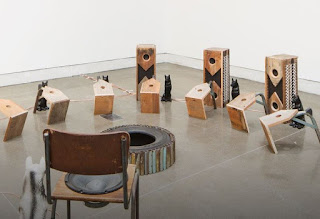I have though decided not to identify where the artists I have to picked out as interesting come from, some it is obvious from the content of their work, but for others it is not so obvious and in this ambiguity I think there is an interesting point to be made about how we tend to associate country of origin with how we read the images. If you want to it is of course easy to Google each artist to find out more.
The photographer Gauri Gill had taken wonderful images of Maharashtrian tribesmen wearing papier-mâché masks that she had had made based on certain individual's own sense of themselves as characters. This activity brought together traditional and non traditional notions of how to make images. For me this was three dimensional drawing at its most elemental fused with photography's ability to bring everything within shot into the same world. Perhaps it was the way these images reminded me of shamanistic traditions, but whatever the reason, I found them totally engaging and they fulfilled my personal need to work with images that dissolved the barriers between people and animals or people and objects.
Gauri Gill
The idea that other things besides ourselves could have sentience was something I have been thinking a lot about lately, as well as my work on issues to do with aging and how we enact our views of who and what we are; therefore I was particularly fascinated by what Gauri Gill was doing. The idea of everything being 'actants' in universal as well as local sets of events and entangled interconnections appeals to me more and more.
Shakuntala Kulkarni
Shakuntala Kulkarni
Tavares Strachan
A memorial to Robert Henry Lawrence, the first African American astronaut by the Bahamanian artist Tavares Strachan is of a glowing figure momentarily suspended as it falls to Earth, Robert Henry Lawrence becoming a radiant spaceman midway between drawing and sculpture.
A memorial to Robert Henry Lawrence
Tavares Strachan: Encyclopaedia of invisibility
Thinking about the space race and images coming from a dominant culture there was a contemporary version of The Pioneer Plaque made to reflect the plight of refugees in Halil Altindere's installation, "Space Refugee". In this work Altindere explores the life of Muhammed Ahmed Faris, Syria's first and only cosmonaut. Faris travelled to the Mir space station with a Soviet team in 1987 and was treated as a national hero.However when Faris became a supporter of the opposition movement against Assad, he was forced to leave the country and now lives as a refugee in Istanbul.
Halil Altindere "Space Refugee"
Michael Armitage
Informal drawings that were sketchbook like in their size and format, were collected together to make an installation consisting of white framed drawings made in brown ink wash on white paper. Armitage's paintings weave multiple narratives that are drawn from historical and current news media, internet gossip, and his own ongoing recollections of Kenya. The drawings exhibited being his daily jottings whereby he recorded life in Kenya. This very traditional way of using drawing as a documentation or recording device, is in his paintings merged with imagery taken from websites and other places from within the ubiquitous contemporary image stream. Old and new fusing in a similar way to the fact that village culture in Kenya is in many ways interacting with the effects of global transnational events. The old in the new, the traditional living alongside the contemporary, is a growing reality of modern life.
Frida Orupabo’s collages of black women are made in such a way that they have a sculptural presence. She creates joints between her cut out sections that are rather like those used in certain sorts of puppet making.
Frida Orupabo
Orupabo's awkward body juxtapositions and use of black and white imagery reminded me of how historically black women had been traded as objects, these 'puppets' are though turned to face you, and like Manet's Olympia transcend their position and take on an agency that gives them gravity and a certain presence.
Kemang Wa Lehulere
Kemang Wa Lehulere’s notion of the collective is key to the artist’s practice. As an activist in Cape Town, he established Gugulective in 2006, an artistic platform for performance and social intervention. Both the installations exhibited in the Arsenale and in the Central Pavilion are made from salvaged wood and metal from school desks and chairs. Each element in these works comes together in a web of associations, references, and stories because for Wa Lehulere, personal biography and collective history are inextricable.
Kemang Wa Lehulere
Kemang Wa Lehulere
New technology was also very visible in Venice, I was particularly interested in Ian Cheng's work, because it illustrated how an idea can literally be grown from the implications of computer algorithms.
Ian Cheng
Ian Cheng's work also demonstrated the continuing influence of the comic book on image making. His creation, 'Bob' growing and morphing, living and dying in a computer animation according to rule generated behaviours, as well as having its own comic book story, 'the life of Bob' which was presented as a very large back lit cartoon strip and was also available to buy in comic book form in the biennale shop.
Ian Cheng talks about 'Bob' and other things
See also:
Venice Biennale 2019 part one
Venice Biennale 2019 part three
Venice Biennale 2019 part four
Reflections on other Venice Biennales
2015
Part 1
Part 2
Part 3
Part 4
































Thanks, admin for this information how to build your skills in art. himanshu_cheeku
ReplyDelete